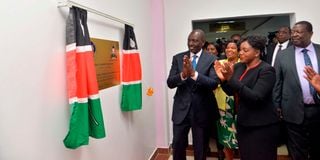Bizarre case of a university ‘at war’ with its hospital

President William Ruto, Health CS Susan Nakhumicha and Prime Cabinet Secretary Musalia Mudavadi during the commissioning of the Kenyatta University Teaching, Referral and Research Hospital Cyberknife Centre on April 24, 2023.
It is surprising and disappointing that Kenyatta University medical students are seeking parliamentary intervention to resolve an impasse that has seen them and their faculty denied access to the hospital’s facilities for teaching and training purposes.
Until the matter became public with news of the petition, I doubt many Kenyans were (and probably still are) aware that such a controversy exists.
As Nairobi Senator Edwin Sifuna said during a debate on the motion, it is a controversy that defies logic and which spotlights some of the irrational decisions that can only be a product of something other than logical debate and analysis.
For starters, the institution is a very expensive public entity whose very name defines what it was always intended to be. It is a 650-bed capacity “Teaching, Referral and Research Hospital”, a national referral hospital equipped to offer specialised “oncology, trauma and orthopaedics, renal, accident and emergency” services.
Its equipment, especially its imaging centre, is very highly spoken of, as well it should be seeing that an impressive Sh11 billion was spent building and equipping the university complex that officially started operations in October 2019.
A key rationale for its existence is that it was to provide the ecosystem that could support the training of medical students from Kenyatta University, over and above providing critical supplementary facilities to ease the pressure that the Kenyatta National Hospital was under as the national referral hospital at the time.
The Kenyatta National Hospital offers this complementarity to the University of Nairobi medical school, just as the Moi Teaching and Referral Hospital supports the Moi University medical students. Similar symbiotic relationships happily exist in other universities and hospitals around the country.
The Kenyatta University students' petition claims that they have been “advised that the teaching section of the hospital has been outsourced to an international organisation”. This section reportedly includes lecture halls, skills labs, a library and teaching administration offices. Apparently, none of the students or lecturers has been given access to these facilities.
The students say that the problem was triggered by the publication of Legal Notice Number 4 of 2019, which made the hospital a standalone parastatal with its own board. But the creation of a parastatal with a board does not mean a split from the mother university that gave the hospital its name and donated the land on which the hospital is built. The Kenyatta National Hospital and the MTRH in Eldoret are standalone parastatals!
Education and training
And a quick check of the Notice in question confirms that apart from the clinical functions expected of the hospital, among the other explicit functions it is mandated to perform is to “provide facilities for medical education for the Kenyatta University and for research either directly or through other cooperating health institutions;” and also “provide facilities for education and training in nursing and other health and allied institutions”. Surely, one cannot be more explicit than that.
There is no mention of the training mandate being outsourced to a third party to the exclusion of Kenyatta University. And there should not be because the two entities are literally joined at the hip.
By denying the students and faculty access to the teaching and learning facilities, the hospital is denying itself relatively inexpensive but high-quality medical expertise. It is missing out on cutting-edge research findings, global collaborative opportunities and the funding that comes along with medical research.
The Kiambu Level 4 hospital that the university is now forced to collaborate with cannot, with due respect to the facility, provide anything close to the quality of synergistic collaboration the KUTRH and the university can achieve. There is also the not-so-small logistic issue of Kiambu being 40 kilometres away from the university.
The existing circumstances have greatly disadvantaged the university’s teaching credentials to the extent that the East African Community national medical and dental practitioners and councils have given the medical school six months to put its house in order “including demonstrating that it can conduct teaching and research”. The risk is that it can be deregistered if it does not satisfy the council.
Since there is no plausible explanation for this circumstance, it must be assumed that this bizarre situation has been triggered or is being sustained by an incongruence of vision and/or approach between the leaderships of the two institutions. It probably is a show of might, egos clashing at the extreme cost of endangering the fortunes of an institution and the livelihoods of hundreds of students. This surely cannot be the intention of the board of the teaching and referral hospital.
Mr Mshindi, a former editor-in-chief of Nation Media Group, is now consulting. [email protected]; @TMshindi





